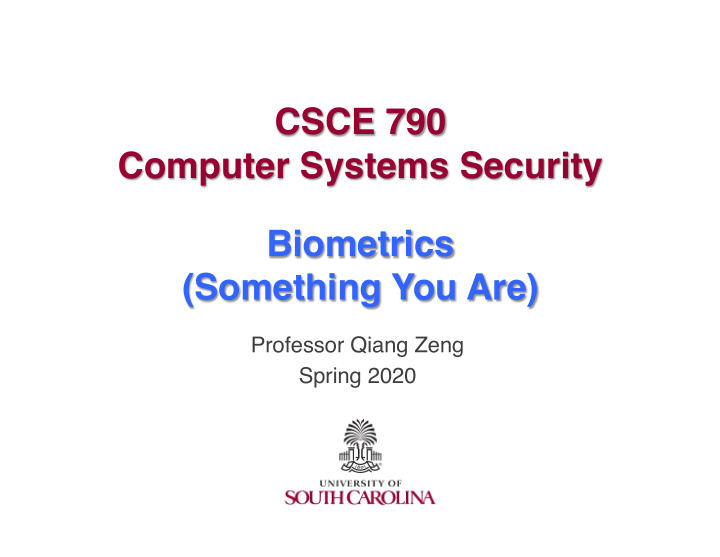



CSCE 790 Computer Systems Security Biometrics (Something You Are) Professor Qiang Zeng Spring 2020
Previous Class • Credentials – Something you know (Knowledge factors) – Something you have (Possession factors) – Something you are (Inherence factors) • How to store passwords securely? • Multi-factor authentication • Time-based One Time Password (OTP) – RSA’s SecurID – Google Authenticator CSCE 790 – Computer Systems Security
Previous class… When you go to an ATM machine to withdraw money, is it two-factor authentication? Yes. Something you know: PIN Something you have: Debit Card CSCE 790 – Computer Systems Security
How to store user passwords • Store hash values only (i.e., never store passwords as plaintext) – It will be a disaster if you store user passwords as plaintext and the server gets compromised • Adding “salts” when hashing – Prevent rainbow table attack – Store “salt1, hash(salt1, password1); salt2, hash(salt2, password2); …” – Now the pre-computed rainbow table is useless • Using a slow hash algorithm – Slow down Brute Force or Dictionary Attack CSCE 790 – Computer Systems Security
Outline • What are Biometrics? • What are Biometrics used for? • Advantages and Disadvantages • How to evaluate its effectiveness? • Framework of a Biometric System • Case studies – Fingerprint – Iris CSCE 790 – Computer Systems Security
Biometrics • Biometrics: the measurement and application of human characteristics – Bio-: life – -Metrics: to measure • Applications: – Authentication: Something you are – Identification: To identify individuals CSCE 790 – Computer Systems Security
Identification vs. Authentication • Identification (also known as One to Many) – A sample is effectively matched against all templates in the database – The user only provide her biometric as input • Authentication (also known as Verification or One to One) – The sample is matched against one pre-selected template. – The pre-selected template is determined by the claimed identity in the form of, e.g., username CSCE 790 – Computer Systems Security
Biometrics are widely used • Smartphones • FBI • US Immigration department • Disney • … CSCE 790 – Computer Systems Security
Advantages and Disadvantages • Advantages – You do not need to remember sth. (as with passwords) – You do not need to carry sth. (as with security tokens) – More convenient and quicker (e.g., compared to typing) – Recognition can be automated (critical for police and FBI) • Disadvantages – Some biometrics may be easily stolen, e.g., fingerprint – Accuracy – Users may not feel comfortable (e.g., scanning eyes) – Costly CSCE 790 – Computer Systems Security
Types of Biometrics • Physiological Biometrics – Fingerprint – Hand Geometry – Iris – Face – DNA • Behavioral Biometrics – Signature – Typing Rhythm – Gait CSCE 790 – Computer Systems Security
Market share CSCE 790 – Computer Systems Security
CSCE 790 – Computer Systems Security
Biometric Template • A biometric template is a digital representation of an individual’s distinct characteristics CSCE 790 – Computer Systems Security
Framework of Applying Biometrics for Authentication CSCE 790 – Computer Systems Security
Five important components • Sensor – Scans the biometric trait of the user • Feature extractor – Processes the scanned biometric data to extract the template • Template database – For storage • Matcher – Compares two templates and outputs a similarity score • Decision module – Determines “Yes” (matched) or “No” (not-matched) CSCE 790 – Computer Systems Security
How to measure accuracy • False Rejection Rate (FRR) as known as False Non-Match Rate (FNMR) – the percentage that the system fails to detect a match between a user’s input template and the user’s stored template • False Acceptance Rate (FAR) also know as False Match Rate (FMR) – the percentage that the system incorrectly matches the input pattern to a non-matching template in the database. – Apple’s TouchID: FAR is 1 in 50,000 CSCE 790 – Computer Systems Security
FRR and FAR CSCE 790 – Computer Systems Security
Fingerprint Characteristics CSCE 790 – Computer Systems Security
An example technology that extracts features from fingerprints • A fingerprint is made of a series of ridges and grooves. Once a fingerprint is captured the system locates the minutia points where the lines of the ridges begin, end, branch off and merge. • These points are then mapped and lines are drawn between points. This creates a map of how each point relates to the other points. The map is then stored as a data stream called a minutia template CSCE 790 – Computer Systems Security
Iris Recognition CSCE 790 – Computer Systems Security
CSCE 790 – Computer Systems Security
Some systems do not work well (yet) • Voice recognition is hard because there are filters which can make a female voice seem male and makes you sound like another, etc. • Face recognition currently has error rates that are too high. • Typing patterns, walking patterns ("gait"), etc. CSCE 790 – Computer Systems Security
Comparison CSCE 790 – Computer Systems Security
Summary • Biometrics – Measurement and applications of human characteristics • Applications – Identification – Authentication • False rejection rate; false accept rate • Fingerprint • Iris CSCE 790 – Computer Systems Security
Recommend
More recommend